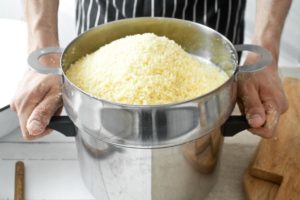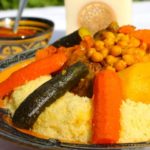Traditional Moroccan Couscous
Couscous is known as 'the North Africa national dish'. It is made of small (about 3mm diameter) steamed balls of crushed durum wheat semolina. It is the "starch" staple of the region. In Morocco (as well as Tunisia, Algeria, Mauritania and Libya), couscous is generally served with vegetables (carrots, potatoes, turnips, etc.) cooked in a spicy or mild broth or stew, and some meat (generally, chicken, lamb or mutton).
Servings: 12 servings
Ingredients
- 32 oz couscous dry (do not use instant couscous)
- 13 cups water
- 1/2 cup oil + 1 tbsp
- 1/2 tsp pepper
- 1 tbsp salt
- 30 threads saffron or 1-1/2 tsp
- 1 butternut or acorn squash 2 lb (pumpkin or gourd) peeled and diced
- 5 turnips peeled and halved
- 1 bunch cilantro rinsed and left whole
- 6 large carrots peeled and halved lengthwise
- 6 medium tomatoes peeled and diced
- 5 medium onions peeled and quartered
- 8 oz chickpeas dry
- 1 lb meat shank bone or mutton, diced
Instructions
- Pre-soak the chickpeas overnight.
- The following day, drain and rinse them, then, put the meat, onions, tomatoes, and chickpeas in the bottom half of the couscous pan (called a couscoussier). Add 1 tsp saffron, cilantro, 1 tsp salt, 1/2 tsp pepper, cover with 12 cups of water, add 1 tbsp of oil and cook at medium temperature.
- In the meantime, prepare the couscous by pouring it into a large colander and rinse it under running water, then drain it and set it aside for 15 minutes.
- Slowly add 1/2 cup oil and 10 threads (1/2 tsp) saffron while stirring the couscous by hand to keep it from lumping. Set the top part of the couscous pan upon its bottom half, and pour the couscous into it.
- Transfer the couscous to the steamer (upper section of couscoussier), taking care not to compress or pack the couscous. Place the steamer on top of the base of the couscoussier.

- If any steam escapes from the joint where the steamer and base meet, you'll want to seal the joint. You can do this in one of 3 ways:1 - Wrap and tie a long piece of damp cloth over the joint.2 - Tightly wrap a long piece of kitchen plastic film around the joint.3 - Wrap and drape a long piece of kitchen plastic film onto the rim of the couscoussier, and then place the basket on top.Once you see steam rise from the couscous, allow the couscous to steam for a full 15 minutes.
- In a small bowl, dissolve 1 tablespoon of salt into 1 cup of water.
- Pour and spread out the couscous onto a platter. Then slowly stir in the salted water into the couscous and let sit for 15 minutes.

- Meanwhile, add the carrots and turnips to the bottom half of the couscous pan.
- After 15 minutes, add the squash and pour the couscous back into the top part of the couscous pan to cook some more.
- After 15 minutes, add the squash into the bottom of couscoussier, then put the couscous back into the steamer – again, don't pack the couscous – and steam a second time for another 15 minutes, timing from when you see the steam rise from the top of the couscous. Remember to seal the joint if you notice steam escaping from the sides.
- When done, pile the couscous onto a serving platter. Arrange the vegetables in a pattern. Then drizzle the couscous with two ladles of the broth to moisten.
- The meat is served separately. Pour the remaining broth into a tureen so guests can choose to further moisten their couscous.
Notes
This is a traditional Moroccan couscous recipe.
French: Couscous with Vegetables (COUSCOUS AUX LEGUMES)
Variation: Couscous Tchicha is made using 2 lbs of barley semolina (instead of couscous) and 1/2 lb of dry fava beans (in place of chickpeas).
